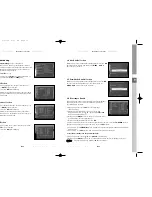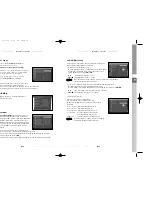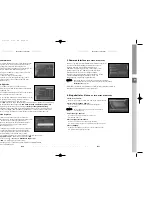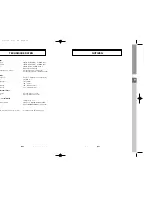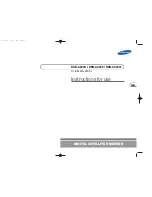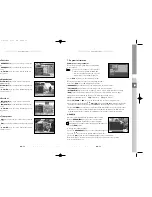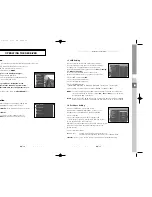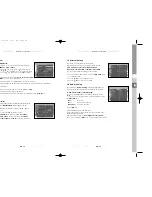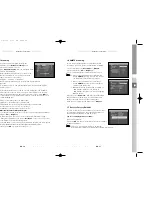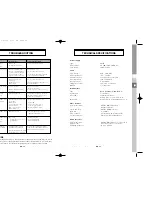
GB-4
D
I
G
I
T
A
L
S
A
T
E
L
L
I
T
E
R
E
C
E
I
V
E
R
GB-5
GB
CONNECTING YOUR “STB”
7. CONNECTING DIGITAL AUDIO SYSTEM
Connect a fiber optic cable between Optical SPDIF on the receiver and Optical SPDIF
on the Digital Audio System.
8. INSERTING COMMON INTERFACE CAM(CONDITIONAL ACCESS MODULE)
AND SMARTCARD
The STB supports Common Interface CAMs under DVB specification.
The CI CAMs include a built-in smart card reader.
●
Insert the smart card into the CAM gently with the gold colored chip upwards
●
Slide in the CAM gently inside the slot so that it sits in the socket tightly.
●
To remove the CAM push the button provided by the side of the CAM slot.
The CAM will be ejected from the socket.
N
No
otte
e
: The following Common Interface CAMs are available now:
IRDETO, CONAX, CRYPTOWORKS, VIACCESS, NAGRAVISION, SECA, Etc.
N
No
otte
e
: Selecting RGB video signal out, YUV (YPbPr) video out turns off.
Selecting coYUV video signal out, YUV (YPbPr) video out turns on.
You can set the various media settings you want.
Place the cursor on this sub menu (System Setup
➔
media setting menu) and press
OK
.
●
Press the
/
keys to move the sub items and press the
/
keys to select the option.
●
Press the
OK
key to confirm.
●
Press the
MENU/EXIT
keys to exit the menu.
●
Select the TV system :
PAL, SECAM, NTSC, PAL
➔
(auto) NTSC, SECAM
➔
(auto) NTSC, NTSC
➔
(auto) PAL, NTSC
➔
(auto) SECAM
●
Select the TV type according to your TV: STANDARD
4: 3
ratio or WIDE SCREEN
16 : 9
ratio type.
●
Select the aspect ratio conversion :
Letter Box, Pan & Scan, Mixed
or
Full
.
●
Select the Video Signal Type :
Composite, Com RGB, Com YUV
or
S-Video
●
Select the RF Channel :
Ch 21~Ch 69
●
Select Broadcasting System :
B/G, I or D/K
1. LOCATION OF THE RECEIVER
Your STB should be placed under proper ventilation.
Don’t put in completely enclosed cabinet that will restrict the flow of air,
resulting in overheating.
The location should be safeguarded from direct sunlight,
excess moisture, rough handling or household pets.
Avoid stacking other electronic components on the top of the receiver.
The location should be safely accessible by the cable from your
antenna system.
2. CONNECTING THE RECEIVER WITH DISH SYSTEM
After installing your antenna system, connect the coaxial cable from the
LNB of your antenna to “DISH INPUT” terminal marked at the rear
of the STB.
All cable connectors should be finger tightened; do not use any kind
of wrench while tightenning connectors. The cable should be 75ohm
impedance coaxial twisted at the end with an “F” type connector.
3. CONNECTING THE RECEIVER TO TV
To connect the receiver with your television, you can use four methods;
Via SCART cable, RF cable, RCA cable or Color component(Y, Pb, Pr) cable.
Color component(Y, Pb, Pr) provides the more faithful reproduction of the colors.
Connect the RF cable to the terminal marked “RF OUT” at the rear panel
of STB and its other end to the TV RF input socket.
In the case of connecting your TV through SCART cable, connect the
SCART connector marked TV to the respective SCART port on the TV.
4. CONNECTING YOUR ANALOG RECEIVER
To facilitate the user using analog receiver to view analog channels,
STB has been provided with a loop through terminal marked as “LOOP”.
Connect the coaxial cable from this terminal to the IF input terminal of
your analog receiver. Now by keeping the STB in standby,
you will be able to tune and view analog channels from
your analog receiver.
5. CONNECTING YOUR VCR
To connect a VCR or DVD player, the STB has been provided with SCART
at the rear marked “AV2”.
Using a SCART connector, the VCR or DVD player can be connected to the receiver.
N
No
otte
e
: This is supported by standby.
6. CONNECTING EXTERNAL AUDIO / HI-FI SYSTEM
To connect any external Audio Hi-Fi system, the receiver has been provided
with two RCA connectors at the back of the receiver,
marked with AUDIO L and R respectively to connect the left and right Audio.
Connecting Figure
CONNECTING YOUR "STB"
MF68-00316A_GB 2/27/04 3:22 PM Page 4





